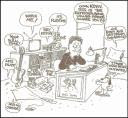 in them. “Notable Women” contains folders for each state, and each state contains folders for each woman I have written about, and some of those folders have folders within them as well, to organize photos, or newspaper articles, or obituaries. In the DOS days, these were called directories and subdirectories, and they were way more work to set up – but the time they save and the many functions they serve make them well worth it. (Disclaimer – I do not remember which writing mentor it was who taught me the value of setting up nested directories. Whoever you were, I thank you!)
in them. “Notable Women” contains folders for each state, and each state contains folders for each woman I have written about, and some of those folders have folders within them as well, to organize photos, or newspaper articles, or obituaries. In the DOS days, these were called directories and subdirectories, and they were way more work to set up – but the time they save and the many functions they serve make them well worth it. (Disclaimer – I do not remember which writing mentor it was who taught me the value of setting up nested directories. Whoever you were, I thank you!)The aforementioned organization of multiple source materials within the folders for particular profile subjects is a pretty obvious use of the “folder” function. Let me suggest a few others that I find very helpful:
The power of excerpting: One of the more difficult things we do, as writers, is to cut our manuscripts to get them down to length. Sometimes this means eliminating pleasing turns of phrase, delightful bits of dialogue, lovingly developed characters or whole episodes of someone’s life. One trick for making this less painful is to create an “excerpts” folder within the folder that contains the manuscript, and then save the deleted material to that folder. In the short run, this quiets the inner narcissist who screams “NO-o-o-o” when any particularly precious bits come up for review – you can convince her that you’re not REALLY deleting the beloved phrases, just saving them for later. In
 the mid-range, if you discover that you really do want to use some deleted bit (perhaps in a different location) it is easy to find it and bring it back. And in the longer run, trimmed-away material may become the core of some other work about your subject.
the mid-range, if you discover that you really do want to use some deleted bit (perhaps in a different location) it is easy to find it and bring it back. And in the longer run, trimmed-away material may become the core of some other work about your subject.To excerpt easily, highlight the passage and copy it (I use
And speaking of the kinds of predilections that are common among writers, the “multi-folder” system can help those of us who are distractible, whether or not we would be labeled ADD.

You know how when you’re working on a project, often with a deadline, and your brain presents you with one idea after another that would make a great story? And you take a quick minute to do a search on the topic to see if anyone else has written a book about it already, and two hours later it’s time to go pick up your kindergartener? Next time, create a new folder in your “ideas” folder, give it a name that will remind you of the idea, and get back to work. Or, if you must, type up a quick summary of your brilliant thought and save it into the folder. Do not open your search engine! The idea will be there after your deadline.
A related use is saving bits of information that you come across while researching another project. As soon as you think “what a great story,” create a folder in your “ideas” folder. Copy the website and paste it into a document and save it, or use a printer emulator* to save the page as a pdf. (I don’t recommend just bookmarking the page – it might not be there when you go back to it.) If you’re as old as I am, you may remember doing this with an actual manila folder, into which you tossed newspaper clippings and scraps of dialogue written on the back of junk mail. The good news is, with computer “folders” you can actually do a search of your hard drive and find the material again! And if one of these ideas actually graduates to becoming a project in its own right, you can drag its folder up to the top level in your directory, or put a shortcut to it on your desktop^, and all the bits and pieces will be readily accessible.
Speaking of which -in the old days, we had to type C:/docs/fl/notewom/texas/carsey + to get to the directory in question. Today there are lots of easier ways to find your stuff, many of them simpler or more efficient than the one that comes with your operating system. I use, and really like, a program called Directory Opus ( http://www.gpsoft.com.au/ ). In addition I run Google Desktop (http://desktop.google.com/ )which allows me to run a google search for files and cached webpages on my computer. But even if you just use Windows Explorer, I encourage you to create lots of folders. You can even add folders called “reviews” within your project folders, and save copies of great feedback emails you get, or nice mentions on other people’s blogs – or starred reviews in SLJ!
*a printer emulator is a program that shows up as a printer when you click “print” but instead creates a .pdf file, which you can then open with Acrobat Reader. These take up less space on your hard drive than the html files you get if you use the “save page” feature in your browser. There are lots of freeware programs available for this – I use deskPdf (http://www.docudesk.com/ )
^To create a shortcut from your desktop in Windows/Vista, right-click on the desktop, choose “new” from the drop-down menu, click the “browse” button and then navigate to the folder. An icon will appear on your desktop that will take you directly to that folder. When you’re done with the project, delete the shortcut to keep your desktop from becoming a disaster area (the folder will still be on your computer, you’ll just have to get to it through the directory). In MacOS this is called an alias and I believe the process is to hold down the Command and Option keys while dragging the file to the desktop from the directory.
+Remember when file names couldn’t be longer than 8 characters?

1 comment:
Great tip about using pdf software to save a webpage! Thanks!
Post a Comment